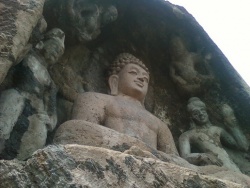Five major principles
five major principles
[五重玄] (Jpn goju-gen )
The five viewpoints from which T'ient'ai (538-597) interpreted the Lotus Sutra:
name,
essence,
quality,
function,
and teaching.
In The Profound Meaning of the Lotus Sutra, T'ient'ai explains that Myoho-renge-kyo, the title of the Lotus Sutra, is not only the name, but also the essence of the sutra, and is endowed with a unique quality, function, and position among all teachings. "Name" signifies the meaning of the title of a sutra. The "Interpretation of the Name" section of Profound Meaning gives a detailed explanation of the title Myoho-renge-kyo and explains why it represents the essence of the Lotus Sutra. "Essence" signifies the ultimate principle of a sutra. The "Clarification of the Essence" section defines the substance of Myoho-renge-kyo to be the true aspect of all phenomena. "Quality" indicates the principal doctrines of a sutra. The section "Elucidation of Quality" defines the principal doctrine of the theoretical teaching (first half) of the Lotus Sutra to be the replacement of the provisional teachings with the true teaching, and the principal doctrine of the essential teaching (latter half) to be the revelation of the Buddha's true identity, i.e., his original attainment of enlightenment, as well as the revelation of the true cause and true effect of his enlightenment. This section of Profound Meaning also states that the quality, or main point, of the sutra as a whole is the causality of the supreme vehicle of Buddhahood. "Function" indicates the benefit and power of a sutra. The "Discussion of Function" section says that the theoretical teaching dispels belief in the three vehicles (teachings for voice-hearers, cause-awakened ones, and bodhisattvas) and arouses faith in the one vehicle of Buddhahood, and that the essential teaching denies the Buddha's attainment of enlightenment in this life and arouses faith in his original attainment of enlightenment in the remote past. Moreover, the function of the Lotus Sutra as a whole is to lead all people to Buddhahood. "Teaching" refers to the position and influence of a sutra with respect to other sutras. The section "Evaluation of the Teaching" asserts that the Lotus Sutra encompasses all other teachings, and that its influence permeates all phenomena. This section introduces the systems of classifying the sutras advocated by the three schools of southern China and the seven schools of northern China, and refutes them with T'ient'ai's own classification of "five periods and eight teachings," a system that defines Myoho-renge-kyo as the supreme sutra. T'ient'ai's five major principles are based on the passage of the "Supernatural Powers" (twenty-first) chapter of the Lotus Sutra that begins the transfer of the essence of the sutra to the Bodhisattvas of the Earth. It reads: "To put it briefly, all the doctrines possessed by the Thus Come One [name], all the freely exercised supernatural powers of the Thus Come One [function], the storehouse of all the secret essentials of the Thus Come One [essence], all the most profound matters of the Thus Come One [quality]—all these are proclaimed, revealed, and clearly expounded in this sutra [teaching]."
